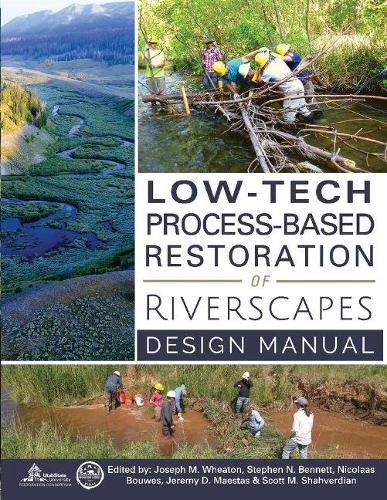Low-Tech Process-Based Restoration of Riverscapes: Design Manual
Joseph M. Wheaton,Stephen N. Bennett,Nicolaas Bouwes,Jeremy D. Maestas,Scott M. Shahverdian

Low-Tech Process-Based Restoration of Riverscapes: Design Manual
Joseph M. Wheaton,Stephen N. Bennett,Nicolaas Bouwes,Jeremy D. Maestas,Scott M. Shahverdian
Stream and riverine landscapes or riverscapes are made up of a series of interconnected floodplain, groundwater, channel habitats, and their associated biotic communities that are maintained by physical and biological processes that vary across spatial and temporal scales. An over-arching goal of riverscape restoration and conservation is to improve the health of as many miles as possible, while ensuring those systems achieve and maintain their potential in self-sustaining ways. This design manual is intended to help the restoration community more efficiently maximize efforts to initiate self-sustaining recovery of degraded riverscapes at meaningful scales. Structural-starvation of wood and beaver dams in riverscapes is one of the most common impairments affecting riverscape health. At a basic level, a riverscape starved of structure drains too quickly and efficiently, lacks connectivity with its floodplain and has simpler more homogenous habitat. By contrast, a riverscape system with an appropriate amount of structure provides obstructions to flow. What follows in the wake of structurally-forced hydraulic diversity are more complicated geomorphic processes that result in far more diverse habitat, resilience, and a rich suite of associated ecosystem services. The purpose of this design manual is to provide restoration practitioners with guidelines for implementing a subset of low-tech tools-namely post-assisted log structures (PALS) and beaver dam analogues (BDAs)-for initiating process-based restoration in structurally-starved riverscapes. While the concept of process-based restoration in riverscapes has been advocated for at least two decades, details and specific examples on how to implement it remain sparse. Here, we describe ‘low-tech process-based restoration’ as a practice of using simple, low unit-cost, structural additions (e.g., wood and beaver dams) to riverscapes to mimic functions and initiate specific processes. Hallmarks of this approach include: An explicit focus on the processes that a low-tech restoration intervention is meant to promote A conscious effort to use cost-effective, low-tech treatments (e.g., hand-built, natural materials, non-engineered, short-term design life-spans) ‘Letting the system do the work’, which defers critical decision making to riverscapes and nature’s ecosystem engineersImportantly, the manual conveys underlying principles guiding use of low-tech tools in process-based restoration in systems impaired by insufficient structural complexity. Although intended to be simple, low-tech restoration still requires some basic understanding of watershed context, riverscape behavior and channel evolution, and careful planning. The manual provides interested practitioners with sufficient conceptual and applied information on planning, design, permitting, construction and adaptive management to get started, as well as references to additional information and resources. Detailed design and construction guidance is provided on two effective low-tech tools: 1) beaver dam analogues (BDAs) for mimicking beaver dam activity, and 2) post-assisted log structures (PALS) for mimicking wood accumulation in riverscapes. Throughout the manual, readers are reminded that the structures themselves are not the solution, but rather a means to initiate specific, desirable processes. Ultimately, embracing the design principles will help practitioners better understand the ‘why’ behind structural interventions and allow for more efficient and effective riverscape restoration.
This item is not currently in-stock. It can be ordered online and is expected to ship in approx 2 weeks
Our stock data is updated periodically, and availability may change throughout the day for in-demand items. Please call the relevant shop for the most current stock information. Prices are subject to change without notice.
Sign in or become a Readings Member to add this title to a wishlist.


